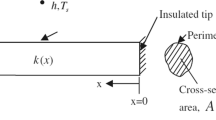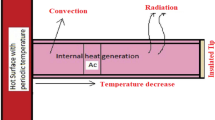Abstract
The thermal performance of longitudinal radiative–convective fins with rectangular, trapezoidal, and concave parabolic profiles was analyzed by the homotopy perturbation method (HPM). The governing equation of the problem was obtained by establishing the energy balance for a longitudinal element on the longitudinal radiative–convective fin. In addition, thermal conductivity, convective heat transfer coefficient, and surface emissivity were assumed to change with temperature. Given its nonlinear nature, the governing equation was solved relying on the HPM. Validating the results from this method with those of the differential transform method, a good agreement was achieved between the two. In parametric studies, the fins were compared in terms of heat transfer rate, effectiveness, and efficiency. Further, the effects of changes in thermal conductivity, emissivity, convection–conduction parameter, and the radiation–conduction parameter were also investigated on the fin performance. The results were suggestive of the potentials of HPM as a reliable tool for solving nonlinear equations such as the energy equation for radiative–convective fins without compromising accuracy or speed. Further, the concave parabolic fin was found to have a higher heat transfer rate, efficiency, and effectiveness than its rectangular and trapezoidal counterparts.






















Similar content being viewed by others
Availability of Data and Material
Applicable.
Code Availability
Applicable.
References
Alam MN, Tunc C (2016) An analytical method for solving exact solutions of the nonlinear Bogoyavlenskii equation and the nonlinear diffusive predator-prey system. Alex Eng J 55(2):1855–1865
Alam MN, Tunc C (2020a) Constructions of the optical solitons and other solitons to the conformable fractional Zakharov–Kuznetsov equation with power law nonlinearity. J Taibah Univ Sci 14(1):94–100
Alam MN, Tunc C (2020b) The new solitary wave structures for the (2 + 1)-dimensional time-fractional Schrodinger equation and the space-time nonlinear conformable fractional Bogoyavlenskii equations. Alex Eng J. https://doi.org/10.1016/j.aej.2020.01.054
Alam MN, Aktar S, Tunc C (2020) New solitary wave structures to time fractional biological population model. J Math Anal 11(3):59–70
Aziz A, Torabi M (2012) Convective –radiative fins with simultaneous variation of thermal conductivity, heat transfer coefficient and surface emissivity with temperature. Heat Transf Asian Res 41(2):99–113
Biazar J, Ghazvini H (2007) Solution of the wave equation by homotopy perturbation method. Int Math Forum 45(2):2237–2244
Cengel YA (2007) Heat transfer: a practical approach, 2nd edn. McGraw-Hill Science, London
Ganji DD (2006) The application of He’s homotopy perturbation method to nonlinear equations arising in heat transfer. Phys Lett A 355(4–5):337–341
Ganji DD, Rafei M (2006) Solitary wave solutions for a generalized Hirota–Satsuma coupled KdV equation by homotopy perturbation method. Phys Lett A 356(2):131–137
Ganji DD, Rajabi A (2006) Assessment of homotopy–perturbation and perturbation methods in heat radiation equations. Int Commun Heat Mass Transf 33(3):391–400
Ganji DD, Ganji ZZ, Ganji HD (2011) Determination of temperature distribution for annular fins with temperature-dependent thermal conductivity by HPM. Therm Sci 15(1):111–115
He JH (1999) Homotopy perturbation technique. Comput Methods Appl Mech Eng 178(3):257–262
He JH (2006) Homotopy perturbation method for solving boundary value problems. Phys Lett A 350(1–2):87–88
Kraus AD, Aziz A, Welty JR (2002) Extended surface heat transfer. Wiley, New York
Liao SJ (1995) An approximate solution technique not depending on small parameters: a special example. Int J Non-Linear Mech 30(3):371–380
Majhi T, Kundu B (2020) New approach for determining fin performances of an annular disc fin with internal heat generation. advances in mechanical engineering. Lecture notes in mechanical engineering. Springer, Singapore
Oguntala G, Sobamowo G, Ahmed Y, Abd-Alhameed R (2018) Application of approximate analytical technique using the homotopy perturbation method to study the inclination effect on the thermal behavior of porous fin heat sink. Math Comput Appl 23(4):62
Pandey P, Kumar S, Gomez-Aguilar JF (2019) Numerical solution of the time fractional reaction–advection–diffusion equation in porous media. J Appl Comput Mech. https://doi.org/10.22055/JACM.2019.30946.1796
Roy R, Ghosal S (2017) Homotopy perturbation method for the analysis of heat transfer in an annular fin with temperature-dependent thermal conductivity. J Heat Transfer 139(2):022001
Roy PK, Mallick A (2016) Thermal analysis of straight rectangular fin using homotopy perturbation method. Alex Eng J 55(3):2269–2277
Torabi M, Yaghoobi H, Aziz A (2012) Analytical solution for convective-radiative continuously moving fin with temperature dependent thermal conductivity. Int J Thermophys 33(5):924–941
Torabi M, Aziz A, Zhang K (2013) A comparative study of longitudinal fins of rectangular, trapezoidal and concave parabolic profiles with multiple nonlinearities. Energy 51:243–256
Yontar O, Aydin K, Keles I (2020) Practical jointed approach to thermal performance of functionally graded material annular fin. J Thermophys Heat Transf 34(1):144–149
Funding
Not applicable.
Author information
Authors and Affiliations
Contributions
All authors contributed to the study conception and design. Material preparation, data collection and analysis were performed by AI, MS and FS. The first draft of the manuscript was written by AI, and all authors commented on previous versions of the manuscript. All authors read and approved the final manuscript.
Corresponding author
Ethics declarations
Conflict of interest
The authors declare that they have no conflict of interest.
Rights and permissions
About this article
Cite this article
Irandegani, A., Sanjaranipour, M. & Sarhaddi, F. Thermal Performance Evaluation of Longitudinal Fins with Various Profiles Using Homotopy Perturbation Method. Iran J Sci Technol Trans Sci 44, 1761–1774 (2020). https://doi.org/10.1007/s40995-020-00973-6
Received:
Accepted:
Published:
Issue Date:
DOI: https://doi.org/10.1007/s40995-020-00973-6




